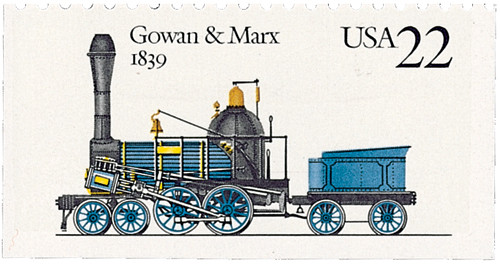
# 2365 - 1987 22c Steam Locomotives: Brother Jonathon
U.S. #2365
1987 22¢ Brother Jonathan
Steam Locomotives Booklet Pane
- Honors what was once the fastest locomotive in the world
- Issued at the Baltimore and Ohio Railroad Museum
- Issued for the 7th annual National Stamp Collecting Month
Stamp Category: Commemorative
Set: Steam Locomotives
Value: 22¢, first-class rate
First Day of Issue: October 1, 1987
First Day City: Baltimore, Maryland
Quantity Issued: 78,995,200
Printed by: Bureau of Engraving and Printing
Printing Method: Lithographed and engraved
Format: Four booklet panes of five stamps per booklet
Perforations: 10 horizontal on 1 or 2 sides
Why the stamp was issued: To pay tribute to the contributions of the different engines that sparked the railroad revolution in America
About the stamp design: Richard Leech based his stamp art on original illustrations of the locomotive.
First Day City: The First Day ceremony for this booklet was held at the Baltimore and Ohio Railroad Museum in Baltimore, Maryland.
About the Locomotives Booklet: Richard Leech was originally hired to design Locomotive stamps in 1979. His initial design was a block of four picturing the Stourbridge Lion, the Best Friend of Charleston, the Gowan & Marx, and the Jupiter. The Citizens’ Stamp Advisory Committee decided they wanted a booklet of five stamps and the Jupiter was removed and the John Bull and Brother Jonathan were added.
The 1987 Locomotives stamps were selected as that year’s annual National Stamp Collecting Month issue. Along with those stamps came the theme, “Steaming Along with Stamp Collecting. All Aboard!”
History the stamp represents: The Brother Jonathan was a passenger train built by John Jarvis in 1832, for the Mohawk and Hudson Railroad. Originally called the Experiment, the name was changed when a wood-burning firebox replaced the previous one designed to burn coal. Brother Jonathan featured a new type of wheel configuration – what came to be known as the 4-2-0. That means there were four wheels on the forward part of the engine, two wheels in the back (or middle), and none trailing behind. It was the first locomotive in the world to have a separate front bogie, which pivoted and stayed on the tracks better than stationary front ends that were previously used.
The Brother Jonathan was a much more stable locomotive, one that didn’t share the tendencies of its predecessor to derail on turns or inclines. It was also fast. For its time, the Brother Jonathan was the speediest locomotive around, able to achieve speeds of 60 miles per hour or more, a world record for that time. The four front wheels became a standard on American trains and the Brother Jonathan was in service for many years to come.
U.S. #2365
1987 22¢ Brother Jonathan
Steam Locomotives Booklet Pane
- Honors what was once the fastest locomotive in the world
- Issued at the Baltimore and Ohio Railroad Museum
- Issued for the 7th annual National Stamp Collecting Month
Stamp Category: Commemorative
Set: Steam Locomotives
Value: 22¢, first-class rate
First Day of Issue: October 1, 1987
First Day City: Baltimore, Maryland
Quantity Issued: 78,995,200
Printed by: Bureau of Engraving and Printing
Printing Method: Lithographed and engraved
Format: Four booklet panes of five stamps per booklet
Perforations: 10 horizontal on 1 or 2 sides
Why the stamp was issued: To pay tribute to the contributions of the different engines that sparked the railroad revolution in America
About the stamp design: Richard Leech based his stamp art on original illustrations of the locomotive.
First Day City: The First Day ceremony for this booklet was held at the Baltimore and Ohio Railroad Museum in Baltimore, Maryland.
About the Locomotives Booklet: Richard Leech was originally hired to design Locomotive stamps in 1979. His initial design was a block of four picturing the Stourbridge Lion, the Best Friend of Charleston, the Gowan & Marx, and the Jupiter. The Citizens’ Stamp Advisory Committee decided they wanted a booklet of five stamps and the Jupiter was removed and the John Bull and Brother Jonathan were added.
The 1987 Locomotives stamps were selected as that year’s annual National Stamp Collecting Month issue. Along with those stamps came the theme, “Steaming Along with Stamp Collecting. All Aboard!”
History the stamp represents: The Brother Jonathan was a passenger train built by John Jarvis in 1832, for the Mohawk and Hudson Railroad. Originally called the Experiment, the name was changed when a wood-burning firebox replaced the previous one designed to burn coal. Brother Jonathan featured a new type of wheel configuration – what came to be known as the 4-2-0. That means there were four wheels on the forward part of the engine, two wheels in the back (or middle), and none trailing behind. It was the first locomotive in the world to have a separate front bogie, which pivoted and stayed on the tracks better than stationary front ends that were previously used.
The Brother Jonathan was a much more stable locomotive, one that didn’t share the tendencies of its predecessor to derail on turns or inclines. It was also fast. For its time, the Brother Jonathan was the speediest locomotive around, able to achieve speeds of 60 miles per hour or more, a world record for that time. The four front wheels became a standard on American trains and the Brother Jonathan was in service for many years to come.












